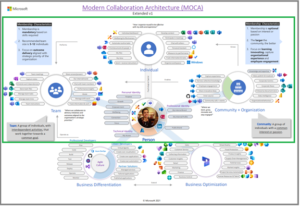In this current world of remote working, people and organizations are continually trying to understand what the best tools are for modern collaboration and how/when to use them. As we find ourselves immersed in changing cultures and mindsets, the direction of where to invest resources is not always obvious.
Additionally, the solution varies based on examples like, but not limited to, what perspective you’re viewing it from, what you want to accomplish, and what technology platform you’re working in (ie: Microsoft, Google, or others). For the purposes of this explanation, we’ll be focused on looking through the lens of working in Microsoft.
What is Modern Collaboration?
The MOCA, Modern Collaboration Architecture (coined by Microsoft) explains Microsoft 365 in a humanistic way. It enables people to understand how Microsoft 365 applications should work together to improve communication, collaboration and information management across individuals, teams, and the entire organization. The “MOCA Standard” areas of focus are:
- Individual
- Team
- Community + Organization
Microsoft recently added “MOCA Extended,” which adds Business Differentiation and Business Optimization into the Modern Collaboration Architecture, but that’s for another post.
Why is Modern Collaboration Important?
With so much information being sent to us in multiple ways, at all times of the day, by several people, it can be challenging to know how to communicate, stay focused, and be productive. These challenges will continue unless we maximize the tools available to us, through deliberate techniques and efforts.
“People spend about 1 hour a day – up to 7 weeks a year – searching for or recreating information. (Spiceworks/Ziff Davis survey commissioned by Microsoft, 2021)
The tools used with Modern Collaboration strive to keep information and assets easily accessible, so time spent searching or recreating information is reduced and/or hopefully eliminated – increasing both productivity and user satisfaction.
Additionally, always “being available” can hinder focus time and productivity. Managing alerts and notifications, as well as setting expectations will allow sharing information and workflow environments to be successful. Supporting each other as you transition to the MOCA is key for a thriving team culture.
What does this look like?
Understanding the MOCA, is the first step in planning how your organization can begin to work in a collaborative nature. Allow your organization to be flexible and adapt, as needed, while implementing processes and finding what works within your organization.
Shown below, is Microsoft’s diagram illustrating the previously mentioned areas of focus. Notice the highlighted green box is the MOCA Standard. As you look at the diagram, it might help to first focus on these four key areas.
- Start with the areas of focus: Individual, Team, Community + Organization that stem from the Person (circles with people in them)
- Review definitions of Team and Community (gray bubbles)
- Review Membership Characteristics of Teams versus Communities (light blue boxes)
- Review quotes for Individual, Team, Community + Organization (small text in bold italics)

Diagram modified from Microsoft’s MOCA on a Page download. Green box highlights what most organizations utilize.
Key Points to Remember
The goal of the MOCA is to help increase productivity and create an effective and efficient collaborative environment. Think about what information is being shared, who needs the information, and how will it be used. Additionally, it’s important to maintain flexibility and recognize when something is not working well and to adapt accordingly.
Let us help!
It can often be challenging for an organization to take a step back and look objectively at how to design their MOCA, Modern Collaboration Architecture. Our team of experts, at eimagine, will guide your organization through the process of analyzing what your collaboration goals are and how to best implement them.
For more information about MOCA or implementing other Microsoft elements, reach out and get started with eimagine, today!
By Elaine Rinehart – Business Analyst, SharePoint Analyst
